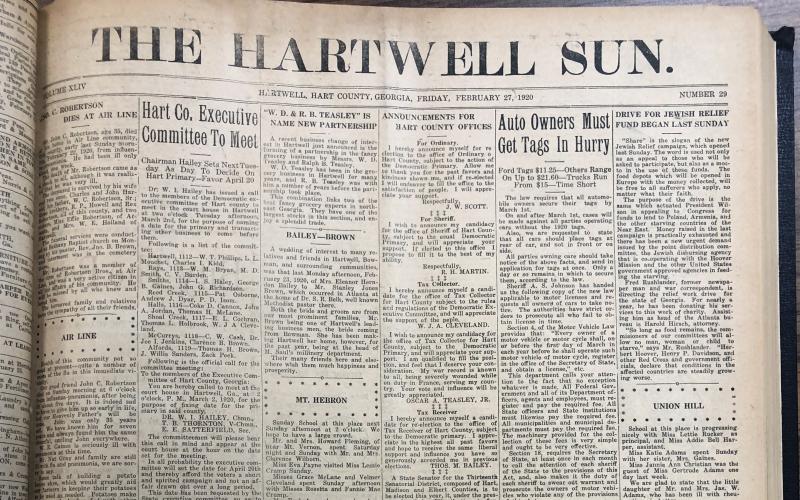Taking a look back at Hartwell’s history as reported by The Hartwell Sun.
Feb. 27, 1920 — It paid to drive a Ford in 1920 — literally.
In an article printed in the Feb. 27, 1920 edition of The Hartwell Sun, officials urged drivers to buy their vehicle tags soon or they would be facing fines from law enforcement.
Prices of tags were listed and Ford drivers only had to pay $11.25 for their vehicle tags, while other makes ranged up to $21.60. Truck tags started at $15.
The article didn’t explain why there was a discrepancy in the prices, but rather explained the new law and local law enforcement’s duty to enforce it.
“Section 21, requires the County Commissioners of each county or the Ordinary, where there are no County Commissioners, to cause the arrest and to prosecute all owners of motor vehicles who fail or refuse to register their cars. The law, therefore creates a body composed of 150 Sheriffs and about 450 County Commissioners as revenue agents. This department assumes that every Sheriff and every County Commissioner will discharge his duty,” The Sun wrote.
Feb. 26, 1943 — Rationing goods during World War II impacted what, and how much, you could buy at the grocery store.
A point value system, assigning points to food items at grocery stores, was announced for the War Ration Book No. 2, which required citizens to purchase goods with a limited number of points.
The Hartwell Sun reported by March 1 grocery stores were to have each item, that was on the ration list, labeled with its point value. Items reportedly ranged in value from one point for a can of baby food to 37 points for a can of apricots.
Each man, woman and child was allotted 48 ration points for the March period.
Here are some of the items “cost” in the most popular sizes: peas 16 points; corn 14; tomatoes 16; green beans 14; pears 21; peaches 21; grapefruit juice 23; tomato juice 32; soup 6.
Feb. 28, 1985 — Bridges throughout Hart County were being upgraded and replaced after a 1982 Georgia Department of Transportation inspection found many of the county’s bridges needed repair to meet state and federal requirements.
About 40 of the estimated 120 county bridges were rebuilt over an 18-month period, and the county planned to repair several more.
Many of the bridges lacked load limit signs, something the DOT wanted changed.
The county road commissioner at the time said the bridges safely support school buses and tractors on a daily bases.
The 40 rebuilt bridges cost in total about $30,000.

